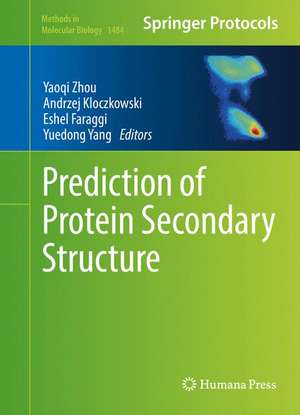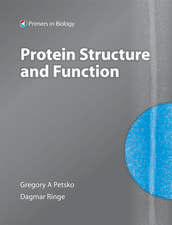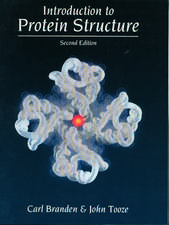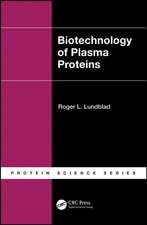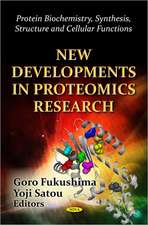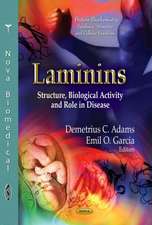Prediction of Protein Secondary Structure: Methods in Molecular Biology, cartea 1484
Editat de Yaoqi Zhou, Andrzej Kloczkowski, Eshel Faraggi, Yuedong Yangen Limba Engleză Hardback – 28 oct 2016
Practical and authoritative, Prediction of Protein Secondary Structure serves as a vital guide to numerous state-of-the-art techniques that are useful for computational and experimental biologists.
| Toate formatele și edițiile | Preț | Express |
|---|---|---|
| Paperback (1) | 781.14 lei 6-8 săpt. | |
| Springer – 8 iun 2018 | 781.14 lei 6-8 săpt. | |
| Hardback (1) | 957.32 lei 6-8 săpt. | |
| Springer – 28 oct 2016 | 957.32 lei 6-8 săpt. |
Din seria Methods in Molecular Biology
- 9%
 Preț: 791.63 lei
Preț: 791.63 lei - 23%
 Preț: 598.58 lei
Preț: 598.58 lei - 20%
 Preț: 882.98 lei
Preț: 882.98 lei -
 Preț: 252.05 lei
Preț: 252.05 lei - 5%
 Preț: 802.70 lei
Preț: 802.70 lei - 5%
 Preț: 729.61 lei
Preț: 729.61 lei - 5%
 Preț: 731.43 lei
Preț: 731.43 lei - 5%
 Preț: 741.30 lei
Preț: 741.30 lei - 5%
 Preț: 747.16 lei
Preț: 747.16 lei - 15%
 Preț: 663.45 lei
Preț: 663.45 lei - 18%
 Preț: 1025.34 lei
Preț: 1025.34 lei - 5%
 Preț: 734.57 lei
Preț: 734.57 lei - 18%
 Preț: 914.20 lei
Preț: 914.20 lei - 15%
 Preț: 664.61 lei
Preț: 664.61 lei - 15%
 Preț: 654.12 lei
Preț: 654.12 lei - 18%
 Preț: 1414.74 lei
Preț: 1414.74 lei - 5%
 Preț: 742.60 lei
Preț: 742.60 lei - 20%
 Preț: 821.65 lei
Preț: 821.65 lei - 18%
 Preț: 972.30 lei
Preț: 972.30 lei - 15%
 Preț: 660.49 lei
Preț: 660.49 lei - 5%
 Preț: 738.41 lei
Preț: 738.41 lei - 18%
 Preț: 984.92 lei
Preț: 984.92 lei - 5%
 Preț: 733.29 lei
Preț: 733.29 lei -
 Preț: 392.60 lei
Preț: 392.60 lei - 5%
 Preț: 746.26 lei
Preț: 746.26 lei - 18%
 Preț: 962.66 lei
Preț: 962.66 lei - 23%
 Preț: 860.22 lei
Preț: 860.22 lei - 15%
 Preț: 652.64 lei
Preț: 652.64 lei - 5%
 Preț: 1055.50 lei
Preț: 1055.50 lei - 23%
 Preț: 883.87 lei
Preț: 883.87 lei - 19%
 Preț: 491.89 lei
Preț: 491.89 lei - 5%
 Preț: 1038.86 lei
Preț: 1038.86 lei - 5%
 Preț: 524.16 lei
Preț: 524.16 lei - 18%
 Preț: 2122.34 lei
Preț: 2122.34 lei - 5%
 Preț: 1299.23 lei
Preț: 1299.23 lei - 5%
 Preț: 1339.12 lei
Preț: 1339.12 lei - 18%
 Preț: 1390.26 lei
Preț: 1390.26 lei - 18%
 Preț: 1395.63 lei
Preț: 1395.63 lei - 18%
 Preț: 1129.65 lei
Preț: 1129.65 lei - 18%
 Preț: 1408.26 lei
Preț: 1408.26 lei - 18%
 Preț: 1124.92 lei
Preț: 1124.92 lei - 18%
 Preț: 966.27 lei
Preț: 966.27 lei - 5%
 Preț: 1299.99 lei
Preț: 1299.99 lei - 5%
 Preț: 1108.51 lei
Preț: 1108.51 lei - 5%
 Preț: 983.76 lei
Preț: 983.76 lei - 5%
 Preț: 728.16 lei
Preț: 728.16 lei - 18%
 Preț: 1118.62 lei
Preț: 1118.62 lei - 18%
 Preț: 955.25 lei
Preț: 955.25 lei - 5%
 Preț: 1035.62 lei
Preț: 1035.62 lei - 18%
 Preț: 1400.35 lei
Preț: 1400.35 lei
Preț: 957.32 lei
Preț vechi: 1167.45 lei
-18% Nou
Puncte Express: 1436
Preț estimativ în valută:
183.19€ • 195.89$ • 152.73£
183.19€ • 195.89$ • 152.73£
Carte tipărită la comandă
Livrare economică 17 aprilie-01 mai
Preluare comenzi: 021 569.72.76
Specificații
ISBN-13: 9781493964048
ISBN-10: 1493964046
Pagini: 256
Ilustrații: XI, 313 p. 67 illus., 56 illus. in color.
Dimensiuni: 178 x 254 x 19 mm
Greutate: 0.79 kg
Ediția:1st ed. 2017
Editura: Springer
Colecția Humana
Seria Methods in Molecular Biology
Locul publicării:New York, NY, United States
ISBN-10: 1493964046
Pagini: 256
Ilustrații: XI, 313 p. 67 illus., 56 illus. in color.
Dimensiuni: 178 x 254 x 19 mm
Greutate: 0.79 kg
Ediția:1st ed. 2017
Editura: Springer
Colecția Humana
Seria Methods in Molecular Biology
Locul publicării:New York, NY, United States
Cuprins
Where the Name “GOR” Originates: A Story.- The GOR Method of Protein Secondary Structure Prediction and Its Application as a Protein Aggregation Prediction Tool.- Consensus Prediction of Charged Single Alpha-Helices with CSAHserver.- Predicting Protein Secondary Structure Using Consensus Data Mining (CDM) Based on Empirical Statistics and Evolutionary Information.- Accurate Prediction of One-Dimensional Protein Structure Features Using SPINE-X.- SPIDER2: A Package to Predict Secondary Structure, Accessible Surface Area, and Main-Chain Torsional Angles by Deep Neural Networks.- Backbone Dihedral Angle Prediction.- One-Dimensional Structural Properties of Proteins in the Coarse-Grained CABS Model.- Assessing Predicted Contacts for Building Protein Three-Dimensional Models.- Fast and Accurate Accessible Surface Area Prediction Without a Sequence Profile.- How to Predict Disorder in a Protein of Interest.- Intrinsic Disorder and Semi-Disorder Prediction by SPINE-D.- Predicting Real-Valued Protein Residue Fluctuation Using FlexPred.- Prediction of Disordered RNA, DNA, and Protein Binding Regions Using DisoRDPbind.- Sequence-Based Prediction of RNA-Binding Residues in Proteins.- Computational Approaches for Predicting Binding Partners, Interface Residues, and Binding Affinity of Protein-Protein Complexes.- In Silico Prediction of Linear B-Cell Epitopes on Proteins.- Prediction of Protein Phosphorylation Sites by Integrating Secondary Structure Information and Other One-Dimensional Structural Properties.- Predicting Post-Translational Modifications from Local Sequence Fragments Using Machine Learning Algorithms: Overview and Best Practices.- CX, DPX, and PCW: Web Servers for the Visualization of Interior and Protruding Regions of Protein Structures in 3D and 1D.
Textul de pe ultima copertă
This thorough volume explores predicting one-dimensional functional properties, functional sites in particular, from protein sequences, an area which is getting more and more attention. Beginning with secondary structure prediction based on sequence only, the book continues by exploring secondary structure prediction based on evolution information, prediction of solvent accessible surface areas and backbone torsion angles, model building, global structural properties, functional properties, as well as visualizing interior and protruding regions in proteins. Written for the highly successful Methods in Molecular Biology series, the chapters include the kind of detail and implementation advice to ensure success in the laboratory.
Practical and authoritative, Prediction of Protein Secondary Structure serves as a vital guide to numerous state-of-the-art techniques that are useful for computational and experimental biologists.
Caracteristici
Includes cutting-edge techniques for the study of protein 1D properties and protein secondary structure Provides step-by-step detail essential for reproducible results Contains key notes and implementation advice from the experts Includes supplementary material: sn.pub/extras
